Think about the last time you made a major purchase online. Was it a plane ticket? An espresso machine? A pair of sneakers?

Now, think about where in your buying process the company you bought from made themselves digitally present. If you bought a pair of sneakers, perhaps you found them by searching "best sneakers for marathons" or "sale on running shoes." If Google was the first place you went to find the product or service you wanted, then you're a very typical buyer in today's internet-driven world.
When a customer takes a certain route on his or her path to conversion then, logically, the company he or she is buying from needs to be digitally present along that path. If not, then the customer’s journey will veer off to a competitor. Or, worse, the customer won't be able to find his or her way, and will end up frustrated and bereft of the product or service.
In order to accommodate the customer’s journey, the business needs to guide the way by being proactively present from an online search standpoint in order to guide the way. That's where your search engine optimization (SEO) strategy comes in -- getting found online can become an integral part of your customers' journey.
The question is: How do we take a theoretical framework of a customer journey and integrate it into the tactical strategy of SEO implementation?
That's what I'll dive into in this post. First, I'll define the two marketing activities that we are discussing: The customer journey, and then SEO strategy. Then, I'll show you how to implement a successful SEO strategy aligned with a typical customer journey.
First, what exactly is a customer journey?
A great way to understand a customer journey is to visualize it using a customer journey map. Marketing Consultant Kerry Bodine recently defined the customer journey map in a brilliant way: "Really simply, all a journey map is, is it's an illustration that shows all the different steps that your customers go through as they do business with you over time."
She created a video on the subject that I think is a must-watch -- because you’ll discover not only what a journey map is, but how to make one. Win-win. Here it is:
A customer journey map fulfills two primary objectives, according to UK-based customer data thinktank CustomerChampions:
- It maps the experience that you want to provide to the customer.
- It maps the experience that the customer would like to receive.
These two objectives are integrally connected to the other in the first case, company services customer; in the second, customer receives service.
The great thing about customer journey maps is that they put customers first. By sketching this sticky-note map of people progressing through a theoretical funnel, you are putting the focus on customers. Isn’t that the way every organization should function — elevating, honoring, and giving pride of place to the customers? I tend to think so.
You might be wondering at this point whether a customer journey map is the same thing as a sales funnel. The answer is no -- sales funnels provide a broad-based sketch of a process, but they don’t actually map the journey. Although a customer journey map can theoretically be placed within a funnel, they are two separate things serving two separate purposes.
Okay, what does a customer journey look like?
Let's take a look at four examples of real customer journey maps.
Example 1
One of the best examples of a customer journey that I’ve found is from Rehash.org. Their customer journey map, pictured below, holistically maps the customer’s stages (you’ll see some funnel elements here), their actions, their thoughts, and their feelings, and how it all integrates with their engagement with the company.

Example 2
Don't worry about the small print on this map -- I've included it here to show how the funnel provides a diagrammatic structure for the journey as a whole. The circles — “awareness,” “research,” “purchase,” — are a rough parallel to the sales funnel.

Example 3
Some customer journeys are largely offline, like the one diagrammed below. However, even when 90% of the journey is offline, the critical starting point is online -- when the customer first searches in Google. There is no way that the journey below could take place unless the initial phase were successful. In the map below, the company calls this initial stage simply “Found via Google" (see the red arrow I've added in below).
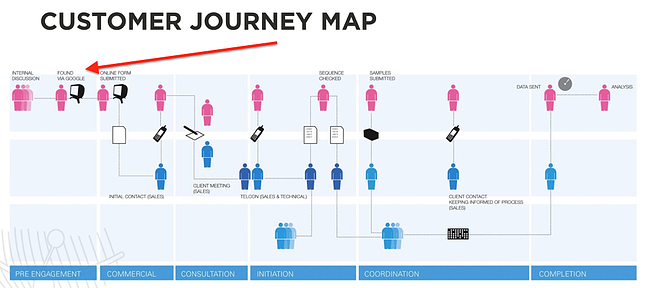
Let’s all take a step back and think about that for a second, shall we? This is an example of the necessity of integrating the customer journey with an SEO strategy. How does the customer “find via Google” unless the company’s journey strategy is connected to the SEO strategy?
Example 4
The importance of search optimization integration is really driven home with the journey map below. Notice how this particular customer journey begins with a YouTube video, continues through a PPC ad, and progresses to the end entirely online.

So once your customer journey is in place, you’re ready to deliver to the customer in the area of search engine optimization. Rubber, meet road.
Now that we know what a customer journey might look like, what does the SEO strategy look like?
An SEO strategy is the implementation of search engine optimization techniques to guide a customer to the targeted web page. Laura Lippay, former Yahoo marketing manager, traced out an 8-step strategy in a series of Moz articles. Here are her eight steps:
- Define Your Target Audience and Their Needs
- Categorized Keyword Research
- Finding Gaps and Opportunities
- Define Competitors
- Spying On (and Learning From) Your Competitors
- Customized SEO Strategy & Recommendations
- Must-have SEO Recommendations
- Prioritize and Summarize
Click here if you'd like to learn more about SEO strategy -- but since I'm talking to a pretty SEO-savvy audience already, I want to instead show a few specific cases of how an SEO strategy intersects with a customer journey map.
Here, I'll use an example of a health insurance customer journey map, which shows how tightly integrated SEO is with the customer journey. My annotations -- the red arrows -- indicate areas in which search engine optimization will affect the journey.
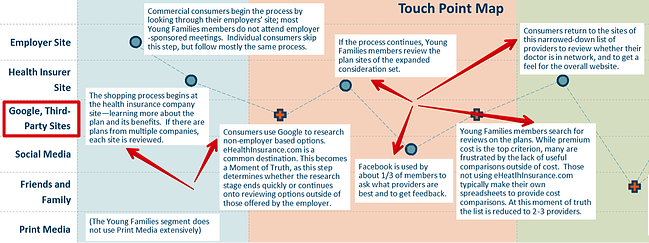
The example above is built on a purchase environment that is mostly centered online. But do you remember the example from earlier of an offline customer journey map? Getting found on Google was where it all started, which places SEO in a critical part of the customer journey.
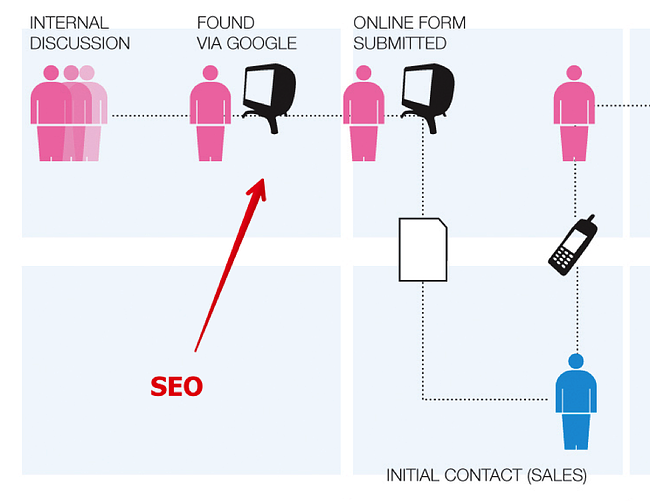
Let’s be honest, though. Google doesn’t give the customer a solution; you give the customer a solution by being present in Google’s search results. In other words, you need to optimize your content for SEO in order to get in front of the user on their journey in the first place.
A Simple Model for Implementing SEO Along the Customer Journey.
Now that the stage is sufficiently set, I want to discuss the actual implementation. How does one add a layer of SEO strategy atop a customer journey map?
The Model
The model is very simple: The phases of the customer journey that involve online search must, by necessity, involve one of three types of search actions by the customer: navigational search, informational search, or transactional search. Each of these phases is correlated with a different type of search query. In order to tailor your SEO strategy to the customer journey, your SEO strategy must feed into each of these three types of searches.
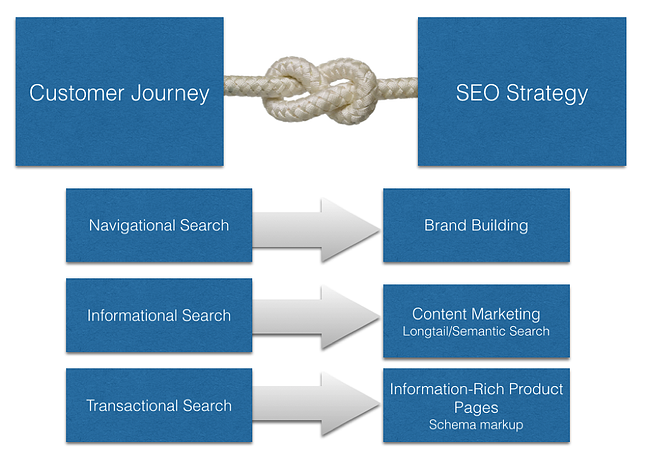
To help you understand this, let's take a look at a few examples of specific stages within customer journey maps, and point out the type of search involved in these stages.
Rehash.org’s customer journey involves searches for their own brand’s website (navigational), and queries involving information on organic food recycling and its benefits. In both cases, rehash.org wants to gain this level of search traffic in order to invite customers on the journey.
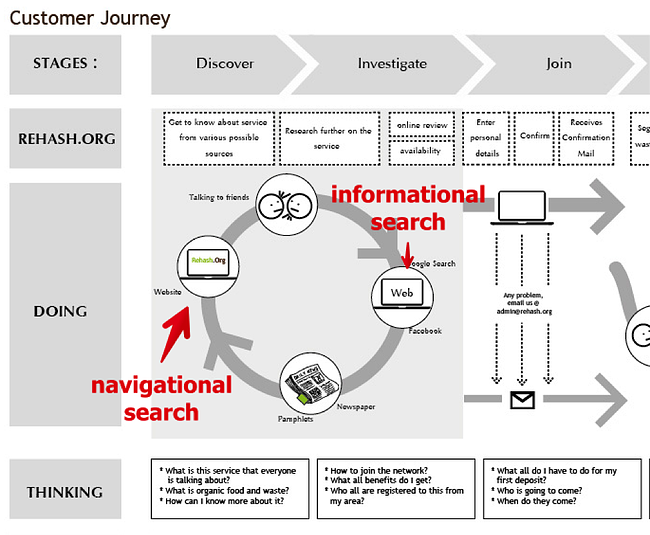
Rehash.org also seeks transactional searches when customers look for coupons. Queries like “coupons for rehash” or “organic food recycling coupon” are considered transactional.
Below is a portion of the customer journey map for a suburban mom preparing for a family vacation. This is how Donna’s search type coincides with her journey:
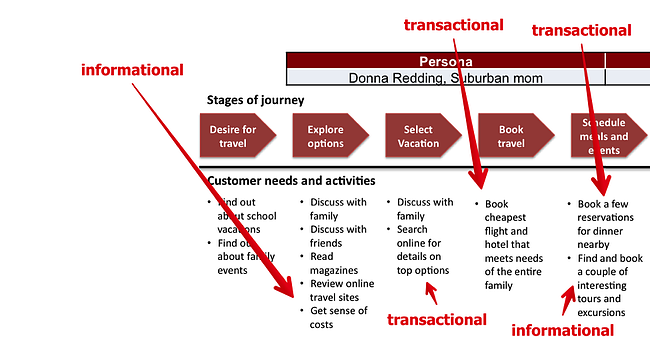
The sample buying process diagrammed in the journey map below also involve each of the types of search queries:
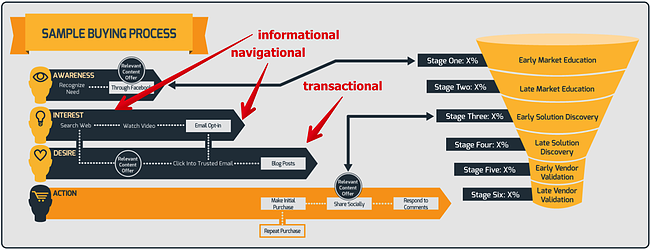
You’ll notice that customer journey maps have a lot of variation in terms of how they are laid out and displayed: it may be simple or complex; it may indication a customer’s experience; or it could simply show the customer’s actions. The journey map might be vertical, horizontal, or circular. Regardless, each journey map will somehow include one or more of the search queries: Navigational, transactional, and/or informational.
Putting This All Into Action
Now that we know what a customer journey map is, and we know what an SEO strategy is, and we know that they’re connected by means of three search query types -- navigational, transactional, and informational -- it’s time to put the plan into action. Here are the four steps to follow:
1) Create your own customer journey map.
The more detailed this map, the better. I again refer you to Kerry Bodine’s Customer Journey Map video.
2) On your map, identify the specific points points at which a user is conducting one of the three types of search queries (navigational, transactional, or informational).
A single phase or point in the map may involve more than one search type. For sake of brevity, Kerry’s map was pretty simple. The first step in this process -- ”searches for shoes” -- could involve any of the three types of queries.
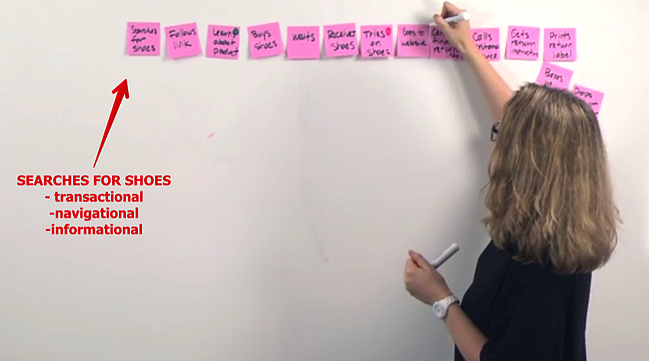
3) Make a list of keywords/queries for each point in the customer journey that involves a specific query type.
On your customer journey map, you have a series of points where the journey involves a query type. Use this query type to develop a list of keywords for each one.
For example: Donna, the suburban mom, is planning her famiy’s vacation. She’s at an early point in the journey -- just getting a sense of costs. At this point, she is conducting informational searches. Here is the information you have:
Type of website: Family vacation planning service
Customer: Suburban mom planning for family vacation
Point in customer journey: Getting a sense of travel costs for her upcoming family vacation.
Query type: Informational
Possible Keywords:
- family vacation cost
- cost for family of 4 to go to disney world
- vacation cost calculator
- how much vacation can I afford
- average vacation cost for family of 4
- average vacation cost
- cost vacation ireland
- cost vacation
- low cost family vacation ideas
4) Connect each keyword to a specific method of SEO strategy.
Now, take those keywords and plug them into your SEO strategy. How? Let’s take one keyword from the above example -- "how much vacation can I afford?" Here's what you might do:
- Create a page on the website
- Page title: “How much vacation can I afford? | Vacation Planning”
- H1: “How much vacation can my family afford?”
- Article: Discuss answers to this question in the article, and provide a CTA at the end.
- Create a series of four evergreen blog articles that deal with this question. Use this keyword, and any longtail variations of ”how much vacation can I afford?"
- Create an infographic that answers the question “”how much vacation can I afford?"
- Interview several experts on vacation affordability, and post a video series on YouTube.
After conducting an effort like that, you will start to dominate that keyword. More to the point, you will also dominate this phase of the customer journey. Whenever the potential customer engages in the informational search for this phase, they will likely see your website in the search results.
Let’s review the process to make sure you really know it:
- Create a customer journey map. Brainstorm. Have fun. Use sticky notes. Drink coffee.
- Draw out the points in the journey where a customer is conducting a specific search query type. Draw a circle around it. Put a sticky note above it. Write “transactional,” “navigational,” or “informational.”
- Write down a list of keyword for each point. More sticky notes perhaps?
- Direct each keyword into a specific method of SEO strategy. Do awesome things.
In a nutshell, if you’re interested in making your marketing better, and you don’t yet have a customer journey map, then you’re going to want to make one.
But don’t stop there. A customer journey map is an excellent exercise, but without SEO implementation, it’s going to be less than productive. As Kerry Bodine explained in her video, “The interesting thing is that not only do marketers need to care about these journey maps, but everyone else in the organization does as well.” That includes SEOs and other digital marketing movers and shakers.
As you shift your customer journey map into the realm of SEO, you’ll start to see a major uptick in traffic, conversions, and all those other good things.
Your turn. What do you think? How does a customer journey map influence SEO, and how should you bring the two together?
Image Credit: Service Design Tools, Rehash.org via Tumblr, marcommmusings, m-journal.cz, m-journal.cz, Service Design Platform, Experience Matters, Big Scary Cranium
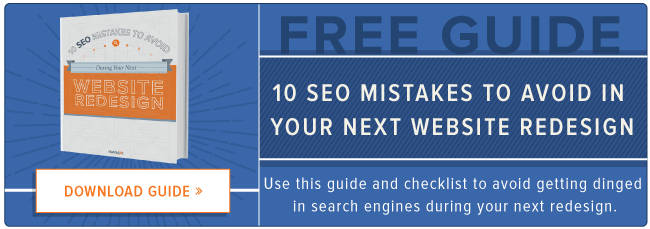



![How to Develop a Go-to-Market Plan That Works [+Free Template]](https://blog.hubspot.com/hubfs/Developing%20a%20Go-to-Market%20Plan-1.jpg)